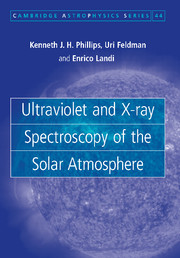Book contents
- Frontmatter
- Contents
- Preface
- 1 The solar atmosphere
- 2 Fundamentals of solar radiation
- 3 Fundamentals of atomic physics
- 4 Mechanisms of formation of the solar spectrum
- 5 Plasma diagnostic techniques
- 6 Ultraviolet and X-ray emission lines
- 7 Spectrometers and imagers for observing the solar ultraviolet and X-ray spectrum
- 8 Quiet Sun and coronal holes
- 9 Active regions
- 10 Solar flares
- 11 Element abundances
- Appendix 1 Units
- Appendix 2 Line lists
- Glossary
- Further reading
- References
- Index
11 - Element abundances
Published online by Cambridge University Press: 07 December 2009
- Frontmatter
- Contents
- Preface
- 1 The solar atmosphere
- 2 Fundamentals of solar radiation
- 3 Fundamentals of atomic physics
- 4 Mechanisms of formation of the solar spectrum
- 5 Plasma diagnostic techniques
- 6 Ultraviolet and X-ray emission lines
- 7 Spectrometers and imagers for observing the solar ultraviolet and X-ray spectrum
- 8 Quiet Sun and coronal holes
- 9 Active regions
- 10 Solar flares
- 11 Element abundances
- Appendix 1 Units
- Appendix 2 Line lists
- Glossary
- Further reading
- References
- Index
Summary
Introduction
Since the early days of solar spectroscopy, the Solar System composition has been considered to be among the most fundamental set of parameters in astrophysics. Russell (1929) in his pioneering research succeeded in deriving the abundances of the 56 elements whose signatures he recognized in the photospheric spectrum of the Sun. Since then a significant body of research regarding the abundances of all elements in the solar photosphere has been accumulated. Much of the research on the composition of the solar photosphere is summarized in a number of review articles, e.g. Cameron (1970), Anders & Grevesse (1989), Grevesse & Sauval (1998), Grevesse et al. (2005).
The Sun, and the nebula out of which it was formed, is composed (by numbers of atoms or ions) of ~90% hydrogen, ~10% helium, and slightly over 0.1% of heavier elements. Oxygen (atomic number Z = 8), the most abundant element after H and He, has an abundance that is over three orders of magnitude lower than H. Ne (10), Mg (12), Si (14), and Fe (26) have abundances over four orders of magnitude lower than the abundance of H. The abundances of Na (11), Al (13), Ca (20), and Ni (28) are five to six orders of magnitude lower than that of H, and K (19) is almost seven orders lower. Copper (29) and other heavier elements are more than seven orders of magnitude less abundant than H. Spectral lines emitted by ions whose atomic numbers are larger than Z = 28.
- Type
- Chapter
- Information
- Ultraviolet and X-ray Spectroscopy of the Solar Atmosphere , pp. 282 - 296Publisher: Cambridge University PressPrint publication year: 2008

